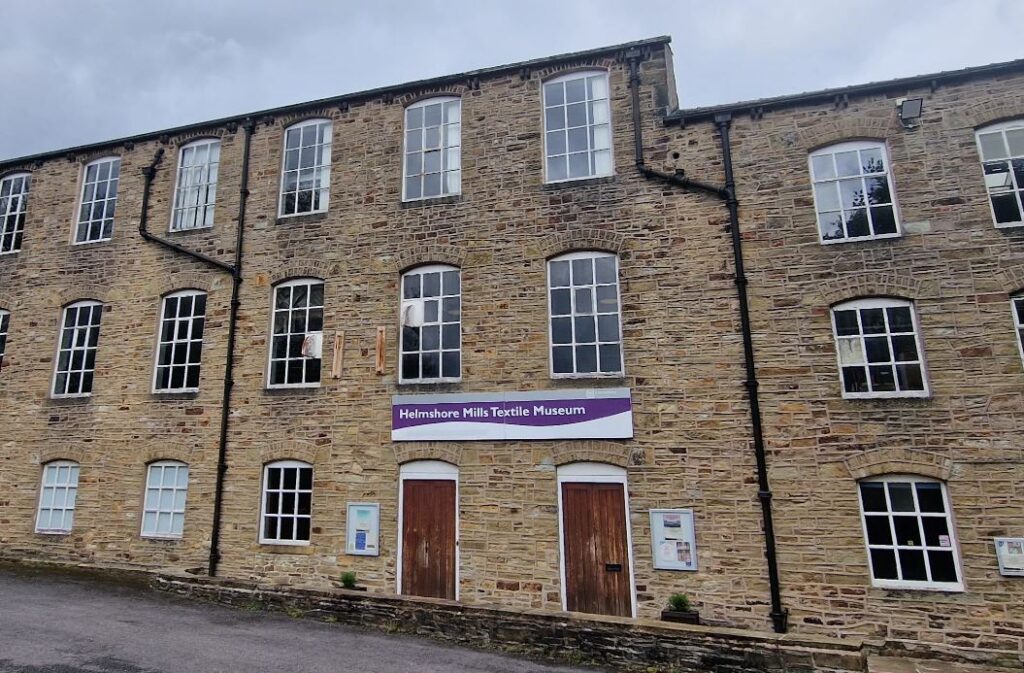
The Helmshore Mills Textile Museum is a remarkably vivid reminder of Britain’s industrial rise, nestled in the picturesque Rossendale Valley. The faint hum of preserved machinery blends with the smell of oil on iron to create a sensory-rich experience that never fails to enthrall both first-time visitors and returning locals. Helmshore’s unvarnished authenticity provides a welcome contrast to those accustomed to refined exhibitions in big cities; it is gritty, captivating, and incredibly successful in capturing the way textile innovation once throbbed in northern England.
Higher Mill was first built in 1796 as a wool fulling mill that was driven by the Ogden River. The procedure was surprisingly unsanitary for its time. Urine was collected in clay pots by local households for use in ammonia-based fulling treatments, which was an awkward but essential step in the textile cycle. Cotton spinning was added to Whitaker’s Mill decades later, adding to the site’s increasing importance. Despite their humble appearance, both mills played a pivotal role in a movement that revolutionized rural life and brought machine labor at a never-before-seen pace.
Key Details about Helmshore Mills Textile Museum
| Attribute | Information |
|---|---|
| Name | Helmshore Mills Textile Museum |
| Location | Holcombe Road, Helmshore, Rossendale, Lancashire, BB4 4NP, United Kingdom |
| Historic Components | Higher Mill (1796 – Wool Fulling), Whitaker’s Mill (1820s – Cotton Spinning) |
| Original Builder/Owner | William Turner and the Turner family |
| Current Management | Lancashire Museums |
| Entry Fee (2025) | £4 Adults, £3 Concessions, Children Free |
| Opening Schedule | Friday to Sunday, 10:00 AM – 4:00 PM (Seasonal); Café Open Thursdays Year-Round |
| Heritage Designation | Scheduled Ancient Monument; Higher Mill is Grade II Listed |
| Official Website | www.lancashire.gov.uk/leisure-and-culture/museums/helmshore-mills-textile-museum/ |
| Main Attractions | Working textile machines, guided tours, hands-on exhibits, historic spinning floors |
By the 1920s, the mills were processing recycled cotton, or “shoddy,” using condensor mule operations. Ironically, that expression, which is now frequently used disparagingly, came from a very effective way to reuse textiles. This approach, which was very novel at the time, predicted current sustainability movements. It should come as no surprise that leaders in the circular economy sector frequently bring up these early industrial tactics to demonstrate how past inventiveness can still influence present and future solutions.
When the mills stopped producing in the 1960s, there was a real risk of demolition. Thankfully, Dr. Rhodes Boyson, a politician, and historian Chris Aspin supported the site’s preservation because they understood its extraordinary historical significance. The Higher Mill Trust was established as a result of their eventually successful efforts. The museum came to life with the assistance of neighborhood volunteers and the donation of antique equipment from Platt International. From Quarry Bank Mill in Styal to Ellenroad Engine House in Rochdale, similar projects have been sparked by this community-led model that was created via perseverance and pride.
Helmshore Mills has evolved into more than just a museum in recent years. It acts as a bridge between earlier efforts and current interest. Each guide speaks with a passion that is both well-informed and intensely personal, especially the seasoned volunteers. They do more than just recount facts; they retell stories, with such clarity that you are momentarily transported into tales of textile tycoons, child labor, and mill girls.
The exhibits themselves do a very good job of combining education and demonstration. You go from the handweaver’s cottage, which has a manually thrown shuttle, to a 16-spindle spinning jenny that dates to circa 1760 as part of a guided tour. It is accompanied by an exceptionally well-preserved Arkwright carding machine. The museum’s crown jewel, the spinning floor, is where visitors can see a 714-spindle Taylor Lang spinning mule in action. It is incredibly humbling as well as fascinating to watch it come to life. These devices, which were manually operated with remarkable accuracy more than a century ago, are reminiscent of a time when mechanical and human endurance were put to the test simultaneously.
The museum’s multi-layered narrative embraces discomfort. The hazardous and frequently exploitative nature of mill work is highlighted in the exhibits. Due to their small size, children were often employed, and airborne fibers caused respiratory disorders to spread widely. However, there is a positive note even here. Helmshore encourages critical thought by openly presenting this darker past, something that many slick institutions that are overtaken by touchscreen screens frequently fall short of.
By 2016, Helmshore’s existence was once more in jeopardy due to a series of funding cuts. The museum was designated for closure, along with four other locations in Lancashire. The public’s reaction was swift and intense. By 2018, operations had resumed on a part-time basis thanks to persistent local pressure and strategic advocacy. This type of rebirth, which has been greatly enhanced by teamwork, is turning into a model for small museums to survive in the United Kingdom. It demonstrates how cultural investment and civic pride can counteract the negative effects of administrative austerity.
The website’s educational value is still very strong. Prearranged visits are often used to bring in schoolchildren, who are then “cotton on” to the era’s relevance both linguistically and literarily through interactive storytelling. The textile roots of phrases like “on tenterhooks” and “heirloom” provide language lessons cloaked in industrial history. Many children are experiencing history for the first time as something alive, loud, and tactile.
Its accessibility is one unexpectedly low-cost feature. The experience is incredibly rich for the price, at just £4 per adult. Access to intricate machinery, knowledgeable guides, and changing seasonal exhibits are all made possible by the small admission fee. It’s a cost that frequently astounds tourists, particularly in a time when cultural institutions usually seem to be priced for tourists rather than residents.
The museum is further anchored in the community by the café, which is open Thursdays and serves as a cozy spot in the winter. Elderly guests are frequently seen drinking tea next to elementary school pupils, sharing the same space, stories, and, on occasion, contentious arguments about which generation put in more effort.
